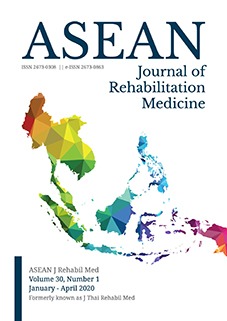Effect of Vojta Therapy on Balance and Walking of Community Dwelling Chronic Stroke Patients
Keywords:
stroke, hemiplegia, balance, walk test, rehabilitationAbstract
Objectives: To evaluate effect of Vojta Therapy on balance and walking of community dwelling chronic stroke patients.
Study design: Single group clinical trial with pre and post test.
Setting: VojtaTherapy clinic, Division of Physical Therapy, Department of Rehabilitation Medicine, Trang Hospital.
Subjects: Community dwelling chronic stroke patients with abnormal gait referred to the VojtaTherapy clinic.
Methods: Every participant did a timed up and go test (TUGT) immediately before and after the VojtaTherapy. Techniques were chosen according to response of patients with 30 minutes per session. Treatment and assessment were repeated once a week for three weeks.
Results: Twenty chronic stroke patients with average age of 63.1 (SD = 13.23) years and average duration after stroke of 58.35 (SD = 52.83) months were enrolled into the study. The median TUGT scores of the first, second and third pre-treatment were 28, 22 and 19.5 respectively. Friedman test demonstrated a significant difference (p < 0.001). Median TUGT Score of the first, second, and third post treatment TUGT score were 22.5, 18 and 18.5 respectively. Wilcoxon test showed significant difference of pre versus post treatments in everysessions (p < 0.0001).
Conclusion: Once a week of VojtaTherapy for three weeks can improve walking in community dwelling chronic stroke patients.
References
Krishnamurthi RV, Moran AE, Feigin VL, Barker-Collo S, Norrving B, Mensah GA, et al. Stroke prevalence, mortality and disability-adjusted life years in adults aged 20-64 years in 1990-2013: data from the global burden of disease 2013 study. Neuroepidemiology. 2015;45:190-202.
Krishnan S, Pappadis MR, Weller SC, Fisher SR, Hay CC, Reistetter TA. Patient-centered mobility outcome preferences according to individuals with stroke and caregivers: a qualitative analysis. Disabil Rehabil. 2018;40:1401-9.
Church G, Parker J, Powell L, Mawson S. The effectiveness of group exercise for improving activity and participation in adult stroke survivors: a systematic review. Physiotherapy. 2019;105: 399-411.
Van Duijnhoven HJ, Heeren A, Peters MA, Veerbeek JM, Kwakkel G, Geurts AC, Weerdesteyn V. Effects of exercise therapy on balance capacity in chronic stroke: systematic review and meta-analysis. Stroke. 2016;47:2603-10.
Wist S, Clivaz J, Sattelmayer M. Muscle strengthening for hemiparesis after stroke: a meta-analysis. Ann Phys Rehabil Med. 2016; 59:114-24.
Tally Z, Boetefuer L, Kauk C, Perez G, Schrand L, Hoder J. The efficacy of treadmill training on balance dysfunction in individuals with chronic stroke: a systematic review. Top Stroke Rehabil. 2017;24:539-46.
Swinnen E, Beckwée D, Meeusen R, Baeyens JP, Kerckhofs E. Does robot-assisted gait rehabilitation improve balance in stroke patients? a systematic review. Top Stroke Rehabil. 2014;21:87-100.
Wevers L, van de Port I, Vermue M, Mead G, Kwakkel G. Effects of task-oriented circuit class training on walking competency after stroke: a systematic review. Stroke. 2009;40:2450-9.
Cano Porras D, Siemonsma P, Inzelberg R, Zeilig G, Plotnik M. Advantages of virtual reality in the rehabilitation of balance and gait: systematic review. Neurology. 2009;90:1017-25.
Lu J, Xu G, Wang Y. Effects of whole-body vibration training on people with chronic stroke: a systematic review and meta-analysis. Top Stroke Rehabil. 2015;22:161-8.
Padilla MG, Rueda FM, Diego IM. Effect of ankle-foot orthosis on postural control after stroke: a systematic review. Neurologia. 2014;29:423-32.
Hong Z, Sui M, Zhuang Z, Liu H, Zheng X, Cai C, et al. Effectiveness of neuromuscular electrical stimulation on lower limbs of patients with hemiplegia after chronic stroke: a systematic review. Arch Phys Med Rehabil. 2018;99:1011-22.
Schinkel-Ivy A, Wong JS, Mansfield A. Balance confidence is related to features of balance and gait in individuals with chronic stroke. J Stroke Cerebrovasc Dis. 2017;26:237-45.
Schmid AA, Yaggi HK, Burrus N, McClain V, Austin C, Ferguson J, et al. Circumstances and consequences of falls among people with chronic stroke. J Rehabil Res Dev. 2013;50:1277-86.
Goto Y, Otaka Y, Suzuki K, Inoue S, Kondo K, Shimizu E. Incidence and circumstances of falls among community-dwelling ambulatory stroke survivors: A prospective study. Geriatr Gerontol Int. 2019;19:2404.
Franse CB, Rietjens JA, Burdorf A, van Grieken A, Korfage IJ, van der Heide A, et al. A prospective study on the variation in falling and fall risk among community-dwelling older citizens in 12 European countries. [Internet]. BMJ Open. 2017;30;7(6):e015827. [cited 2019 Aug 20]. Available from: https://bmjopen.bmj.com/content/bmjopen/7/6/e015827.full.pdf
Vojta V, Peters A. Das Vojta-Prinzip, 3rd ed. Heidelberg: Springer; 2007. p. 18-21.
Khiewcham P, Vongpipatana S, Wongphaet P, Thipsook K. Effect of Vojta Therapy on gait of children with cerebral palsy. J Thai Rehabil Med. 2016;26:91-7.
Beckmann C, Henning D. Sturzprophylaxe in der Geriatriedurch die Anwendung der Vojta-Therapie – Eine kontrollierteklinischeStudie. Poster presented at: Vojta symposium; 2017 June 23-24; Cologne, Germany.
Epple C, Maurer-Burkhard B, Lichti MCand Steiner T. Vojta Therapy in patients with acute stroke-a new approach in stroke rehabilitation. Phys Med Rehabil Int [Internet]. 2018 [cited 2019 August 20]. Available from: https://austinpublishinggroup.com/physical-medicine/fulltext/pmr-v5-id1140.php#Top
Tyson SF, DeSouza LH. Reliability and validity of functional balance tests post stroke. Clin Rehabil. 2004;18:916-23.
Lin JH, Hsu MJ, Hsu HW, Wu HC, Hsieh CL. Psychometric comparisons of 3 functional ambulation measures for patients with stroke. Stroke. 2010;41:2021–5.
Chan PP, Si Tou JI, Tse MM, Ng SS. Reliability and validity of the Timed Up and Go Test with a motor task in people with chronic stroke. Arch Phys Med Rehabil. 2017;98:2213-20.
Proske U, Gandevia, S. The proprioceptive senses: their roles in signaling body shape, body position and movement, and muscle force. Physiol Rev. 2012;92:1651-97.
Bliss TV, Cooke SF. Long-term potentiation and long-term depression: a clinical perspective. Clinics (Sao Paulo). 2011;66:3-17.
Gautschi OP, Stienen MN, Corniola MV, Joswig H, Schaller K, Hildebrandt G, et al. Assessment of the minimum clinically important difference in the timed up and go test after surgery for lumbar degenerative disc disease. Neurosurgery. 2017;80:380-5.






